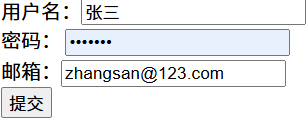第一章:链接
7. 消息转换器
作用: ①浏览器发送请求后页面的局部更新,而不是跳转页面;②浏览器和服务器互发消息,消息格式的转换,主要是json格式和java对象直接的转换。
- 自己理解的概念:
消息: ①浏览器给服务器发送的请求,包含请求行、请求头、请求体;②服务器给浏览器的响应,包含响应的状态行、响应头、响应体
转换器: 将浏览器发送到服务端的信息转换成需要的格式;将服务器返回给浏览器的消息转成需要的格式。
解决的问题:
- 请求体是json格式的字符串,服务器接收并转换为对象形式
- 响应体返回的数据是java对象,转成json格式发送
- 浏览器使用Ajax发送请求,使页面局部刷新
添加依赖:
<!--Jackson库,字符串和java对象互相转化-->
<dependency>
<groupId>com.fasterxml.jackson.core</groupId>
<artifactId>jackson-databind</artifactId>
<version>2.18.1</version>
</dependency>
1. 使用response原生的方法返回字符串
- 方法不再是跳转页面了,使用ajax在当前页面显示返回的字符串
@RequestMapping(value = "/user/1")
public void user1(HttpServletResponse response) throws IOException {
UserBean userBean = new UserBean("张三","123456","[email protected]");
// 将对象转换为json字符串
ObjectMapper objectMapper = new ObjectMapper();
String jsonString = objectMapper.writeValueAsString(userBean);
// 原生的方法返回字符串
response.getWriter().print(jsonString);
}
<body>
<button id="button1">使用response原生方法返回字符串</button>
<div id="show1"></div>
</body>
<script>
document.getElementById("button1").onclick = function () {
alert("button被点击了")
let xmlHttpRequest = new XMLHttpRequest();
xmlHttpRequest.onreadystatechange = function () {
if (xmlHttpRequest.readyState == 4 && xmlHttpRequest.status == 200){
var text = xmlHttpRequest.responseText;//服务器返回的字符串
document.getElementById("show1").innerText = text;
}
}
// [[@{/}]]:thymeleaf语法,动态返回根目录
xmlHttpRequest.open("GET",[[@{/}]] + "user/1",true);
xmlHttpRequest.send();
}
</script>
2. @ResponseBody
作用: controller中的方法返回字符串或者json格式的字符串
- 添加jackson-databind依赖后,java对象和json格式自动转换
@RequestMapping(value = "/user/2")
@ResponseBody
public UserBean user2() {
UserBean userBean = new UserBean("张三","123456","[email protected]");
// 直接返回java对象,依赖Jackson会自动将java对象转为json格式字符串
return userBean ; // 返回的是json格式的字符串,不是模板的文件名
}
- 使用@ResponseBody注解,返回的汉字有乱码问题,解决方案:
<mvc:annotation-driven />
<!-- 这个问题是上面这个配置引起的,导致返回数据时编码格式为8895 -->
<!-- 修改配置后,编码恢复 UTF-8-->
<mvc:annotation-driven>
<mvc:message-converters>
<bean class="org.springframework.http.converter.StringHttpMessageConverter">
<constructor-arg value="UTF-8" />
</bean>
</mvc:message-converters>
</mvc:annotation-driven>
3. @RestController
@RestController 是 @Controller 和 @ResponseBody 的合体,用在类上面
4. @RequestBody
作用: ①浏览器发送的请求体是json格式字符串转成java对象;②浏览器发送的请求体是字符串,接收还是以字符串的格式接收
- html页面发送表单
<form th:action="@{/user/3}" method="post">
用户名:<input type="text" name="name"/><br>
密码: <input type="password" name="password"/><br>
邮箱:<input type="email" name="email"/><br>
<input type="submit" value="提交"></input>
</form>
- 不使用
@RequestBody注解,表单提交post请求,转成对象- 自动封装为UserBean对象
@PostMapping (value = "/user/3")
public String user3( UserBean userBean) {
// 请求体:UserBean{name='张三', password='123456', email='[email protected]'}
System.out.println("请求体:" + userBean);
return "ok"; // 跳转到ok页面
}
- 使用
@RequestBody注解,提交post表单,请求体是字符串,接收到还是字符串- 这里的汉字转成url编码格式,暂时不知道怎么解决
@PostMapping (value = "/user/3")
public String user3(@RequestBody String body) {
// 请求体:username=%E5%BC%A0%E4%B8%89&password=1111&email=zhangsan%40123.com
System.out.println("请求体:" + body);
return "ok"; // 跳转到ok页面
}
- 使用
@RequestBody注解,ajax发送json格式字符串转成对象
let jsonObj = {
"name":"张三",
"password":"123456",
"email":"[email protected]"
}
let jsonData = JSON.stringify(jsonObj);
// 创建XMLHttpRequest对象
let xhr = new XMLHttpRequest();
xhr.open('POST', [[@{/}]] + "user/4", true);
// 设置请求头,表明发送的数据是JSON格式
xhr.setRequestHeader('Content-Type', 'application/json');
xhr.send(jsonData);
@PostMapping (value = "/user/4")
@ResponseBody
public String user4(@RequestBody UserBean userBean) {
// 请求体:UserBean{name='张三', password='123456', email='[email protected]'}
System.out.println("请求体:" + userBean);
return "ok"; // 返回ok字符串
}
5. RequestEntity:类
- RequestEntity:整个请求,从中可以获得请求中的一切,如果请求体是json,通过泛型可转为对象
- 发送get请求
<a th:href="@{/user/5(username='张三',password=123456)}">RequestEntity</a>
@GetMapping (value = "/user/5")
public void user4(RequestEntity requestEntity) {
System.out.println(requestEntity.getMethod()); // GET
System.out.println(requestEntity.getUrl()); // http://localhost:8080/spring/user/5?username=%E5%BC%A0%E4%B8%89&password=123456
}
System.out.println(requestEntity.getBody()); // null
- 通过Ajax,发送post请求,数据是json字符串,可使用RequestEntity的泛型接收该数据
- 添加jackson-databind依赖后,java对象和json格式自动转换
@PostMapping (value = "/user/6")
@ResponseBody
public String user6(RequestEntity<UserBean> requestEntity) {
System.out.println(requestEntity.getMethod()); // POST
System.out.println(requestEntity.getUrl()); // http://localhost:8080/spring/user/6
System.out.println(requestEntity.getBody()); // UserBean{name='张三', password='123456', email='[email protected]'}
return "ok";
}
6. ResponseEntity:类
- 用该类的实例可以封装响应协议,包括:状态行、响应头、响应体。也就是说:如果你想定制属于自己的响应协议,可以使用该类。
@GetMapping("/users/{id}")
public ResponseEntity<UserBean> getUserById(@PathVariable(name="id") int id) {
UserBean userBean;
if (id == 1){
userBean = null;
}else{
userBean = new UserBean("张三","123456","[email protected]");
}
if (userBean == null) {
// HttpStatus:枚举类型。这里的NOT_FOUND是404
return ResponseEntity.status(HttpStatus.NOT_FOUND).body(null);
} else {
// 返回对象的json格式
return ResponseEntity.ok(userBean);
}
}
8. 上传和下载
1. 上传
MultipartFile 是 Spring 框架中的一个接口,主要用于处理文件上传的功能。以下是关于 MultipartFile 的一些关键点:
- 用途:用于接收客户端上传的文件数据。
- 方法:
- String getOriginalFilename():获取文件的原始名称。
- String getContentType():获取文件的 MIME 类型。
- InputStream getInputStream():获取文件的输入流。
- void transferTo(File dest):将上传的文件保存到指定的目标文件。
- byte[] getBytes():将文件内容读取为字节数组。
- form表单上传文件
<!--文件上传表单-->
<form th:action="@{/file/upLoad1}" method="post" enctype="multipart/form-data">
文件:<input type="file" name="fileName"/><br>
<input type="submit" value="上传">
</form>
- transferTo的方法上传
@PostMapping("/upLoad1")
public String up1(@RequestParam( "fileName") MultipartFile multipartFile) throws IOException {
if (multipartFile.isEmpty()) {
return "error";
}
try {
// 获取文件的原始名称
String originalFilename = multipartFile.getOriginalFilename();
// 将文件保存到指定路径
multipartFile.transferTo(new File("/upload" + originalFilename));
return "ok";
} catch (IOException e) {
e.printStackTrace();
return "error";
}
}
- 数据流的方式上传文件(适合大文件,推荐方式)
@PostMapping("/upLoad2")
public String up2(@RequestParam( "fileName") MultipartFile multipartFile,
HttpServletRequest request) throws IOException {
String name = multipartFile.getName();
System.out.println(name);
// 获取文件名
String originalFilename = multipartFile.getOriginalFilename();
System.out.println(originalFilename);
// 将文件存储到服务器中
// 获取输入流
InputStream in = multipartFile.getInputStream();
// 获取上传之后的存放目录
File file = new File(request.getServletContext().getRealPath("/upload"));
// 如果服务器目录不存在则新建
if(!file.exists()){
file.mkdirs();
}
// 开始写
//BufferedOutputStream out = new BufferedOutputStream(new FileOutputStream(file.getAbsolutePath() + "/" + originalFilename));
// 可以采用UUID来生成文件名,防止服务器上传文件时产生覆盖
BufferedOutputStream out = new BufferedOutputStream(new FileOutputStream(file.getAbsolutePath() + "/" + UUID.randomUUID().toString() + originalFilename.substring(originalFilename.lastIndexOf("."))));
byte[] bytes = new byte[1024 * 100];
int readCount = 0;
while((readCount = in.read(bytes)) != -1){
out.write(bytes,0,readCount);
}
// 刷新缓冲流
out.flush();
// 关闭流
in.close();
out.close();
return "ok";
}
2. 下载
<h1>文件下载</h1>
<a th:href="@{/file/download1}">文件下载,第一种方式</a><br>
<a th:href="@{/file/download2}">文件下载,第二种方式</a><br>
- 第一种方式使用Resource ,大文件分段读取
@RequestMapping("/download1")
public ResponseEntity<Resource> download1(HttpServletRequest request) {
// 文件路径
String filePath = request.getServletContext().getRealPath("/upload") + "/1.jpg"; // 替换为实际文件路径
File file = new File(filePath);
// 创建资源对象
Resource resource = new FileSystemResource(file);
// 设置响应头
HttpHeaders headers = new HttpHeaders();
headers.add(HttpHeaders.CONTENT_DISPOSITION, "attachment; filename=" + file.getName());
// 返回 ResponseEntity
return ResponseEntity.ok() // 创建一个 ResponseEntity 对象,状态码为 200(OK)。
.headers(headers) // 设置响应头。
.contentLength(file.length()) // 设置响应内容长度。
.contentType(MediaType.APPLICATION_OCTET_STREAM) // 设置响应内容类型为二进制流。
.body(resource); // 设置响应体为文件资源
}
- 使用byte[],文件会一次性读取到内存,不适合大文件
@RequestMapping("/download2")
public ResponseEntity<byte[]> download2(HttpServletRequest request,
HttpServletResponse response) throws IOException {
File file = new File(request.getServletContext().getRealPath("/upload") + "/1.jpg");
// 创建响应头对象
HttpHeaders headers = new HttpHeaders();
// 设置响应内容类型
headers.setContentType(MediaType.APPLICATION_OCTET_STREAM);
// 设置下载文件的名称
headers.setContentDispositionFormData("attachment", file.getName());
// 下载文件
ResponseEntity<byte[]> entity = new ResponseEntity<byte[]>(Files.readAllBytes(file.toPath()), headers, HttpStatus.OK);
return entity;
}
9. 异常处理器
10. 拦截器
- 实现
HandlerInterceptor接口中的三个方法:
public class Interceptor1 implements HandlerInterceptor {
@Override
public boolean preHandle(HttpServletRequest request, HttpServletResponse response, Object handler) throws Exception {
System.out.println("1号拦截器:controller方法执行之前");
// 返回true则会继续执行,返回false则会中断执行,不会执行controller中的方法
return true;
}
@Override
public void postHandle(HttpServletRequest request, HttpServletResponse response, Object handler, ModelAndView modelAndView) throws Exception {
System.out.println("1号拦截器:controller方法执行之后");
}
@Override
public void afterCompletion(HttpServletRequest request, HttpServletResponse response, Object handler, Exception ex) throws Exception {
System.out.println("1号拦截器:controller方法执行完成,并且渲染完成之后");
}
}
- 在springmvc的配置文件中配置拦截器
<!-- 配置拦截器,可配置多个拦截器,每个拦截器的路径可单独设置 -->
<mvc:interceptors>
<!-- 拦截器的执行顺序就时按照配置的顺序执行 -->
<mvc:interceptor>
<!-- 拦截路径 -->
<mvc:mapping path="/"/>
<!--除 /test 路径之外-->
<mvc:exclude-mapping path="/test"/>
<bean class="org.example.springmvc.Interceptors.Interceptor1"/>
</mvc:interceptor>
<mvc:interceptor>
<mvc:mapping path="/"/>
<!-- 第二种引入方式:使用ref引入需要两个条件
①需要拦截器纳入spring管理,在类上加 @Component注解
②包扫描范围中
-->
<ref bean="interceptor2"/>
</mvc:interceptor>
<mvc:interceptor>
<mvc:mapping path="/"/>
<bean class="org.example.springmvc.Interceptors.Interceptor3"/>
</mvc:interceptor>
</mvc:interceptors>
- 执行结果
1号拦截器:controller方法执行之前
2号拦截器:controller方法执行之前
3号拦截器:controller方法执行之前
3号拦截器:controller方法执行之后
2号拦截器:controller方法执行之后
1号拦截器:controller方法执行之后
3号拦截器:controller方法执行完成,并且渲染完成之后
2号拦截器:controller方法执行完成,并且渲染完成之后
1号拦截器:controller方法执行完成,并且渲染完成之后
- 假设3号拦截器的
preHandle方法返回false
1号拦截器:controller方法执行之前
2号拦截器:controller方法执行之前
3号拦截器:controller方法执行之前
2号拦截器:controller方法执行完成,并且渲染完成之后
1号拦截器:controller方法执行完成,并且渲染完成之后
